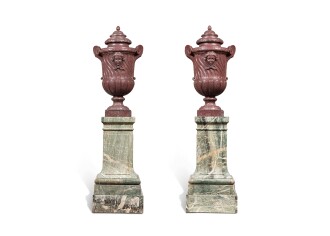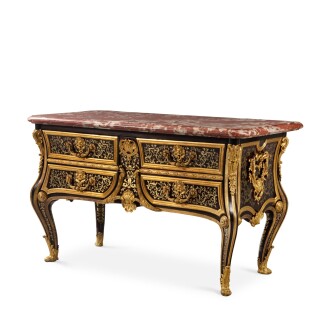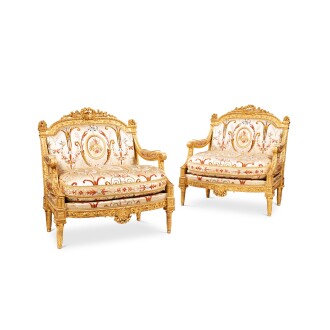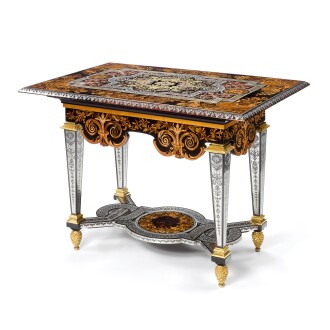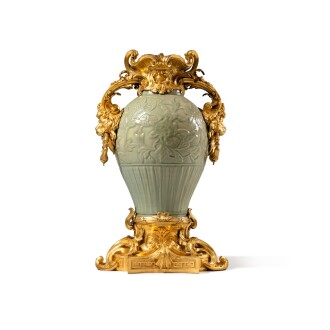T he magnificent treasures that were housed in the Hôtel Lambert are testament to its legendary status. The first volume of the auction series showcases the most iconic works of art, which were painstakingly chosen and collected in the longstanding tradition of the greatest patrons and collectors over the centuries. The selection spans Old Master paintings, Savonnerie carpets, Gobelins tapestries, incredible gilt-bronze mounted porcelain, celebrated silver, masterpieces of majolica, ébénisterie and menuiserie from the most talented craftsmen – all with prestigious provenance at the highest level. These timeless pieces have all made an impact on the history of decorative arts, and will continue to do so in this next chapter.
Proceeds from the sale to support The Al Thani Collection Foundation
Auction Highlights

The Restoration of the Hôtel Lambert
by Alain-Charles Perrot

Hôtel Lambert is one of the most prestigious 17th-century residences in Paris. It is important for the quality of its location, its architecture and its decoration. Located on the tip of Île Saint-Louis it opens onto the Seine. It was initially built for Jean-Baptiste Lambert and completed for his brother Nicolas Lambert de Thorigny in 1648 while Louis XIV was still an adolescent.
Jean-Baptiste Lambert called upon a young architect, Louis Le Vau, to design the hotel and come up with an innovative floorplan. It is thought that the garden was designed by a young André Le Nôtre, and indeed that it was one of his first projects. The decoration was designed by the painter Eustache Le Sueur. He was succeeded by Charles Le Brun, freshly back from Rome, who conceived and executed all the décors of the Hercules Gallery. Thus Hôtel Lambert features work by the three great artists – albeit at a young age – who left their mark on the Louis XIV period, since he went on to entrust them with the project of the Château de Versailles.

The Hôtel Lambert is also remarkable for the personalities who lived there or frequented it, including the philosophers Voltaire and Rousseau, the writers George Sand and Eugène Sue, and the composer Chopin. When the Lambert family sold the property, it passed through various aristocratic and banking families in the 18th century who held brilliant literary salons, adding the prestige of its visitors to the value of its architecture. During the 19th century, the building fell into disrepair after the French Revolution. It was inhabited by the Czartoryski family, followed by – in the 20th century – Baron de Redé, the Rothschild family, and lastly His Highness Sheikh Hamad bin Abdullah Al Thani and his immediate family.

Through its eventful history, the hotel has managed to maintain its 17th-century decorations. Some were renovated in the early 18th century, but all are remarkable and precious.
After it was purchased by the Al Thani family, a massive restoration campaign was launched, and as the head architect of Historic Buildings I was the construction manager. The entire monument was refurbished. The roofs were restored to their original design. The façades were cleaned and renovated, and the woodwork was overhauled: all the original joinery was preserved and repaired, while other pieces were replaced by models identical to the outdated versions.
Inside, it was necessary to remove all the paved and parquet floors, panelling, gilding, ceilings, and paintings by the great masters which are integrated into the decorations. They were restored at a workshop and reinstalled, offering the possibility to install the modern systems required for the comfort of a home today.
The artwork, paintings, sculptures, and marble pieces were also refurbished, each by highly skilled and qualified craftsmen. Through all this work, the beauty of the original decoration has been restored in the respect of its history traditional savoir-faire.
The restoration work was carried out through a collaboration with the Historic Monuments department of the French Ministry of Culture and the scientific committee specially created for the project in order to follow up on the work.
Let us mention the intervention of the Pinto interior decoration and design firm, which contributed to the decoration.
What most excited me in the development of the Hôtel Lambert restoration project and its execution is the notion of “excellence”. The excellence of the artists who designed and crafted these exceptional spaces. The excellence of the families that inhabited this hotel in the past. The excellence sought-after by His Highness Sheikh Hamad bin Abdullah Al Thani, and the excellence in the restoration project that I developed. The excellence of the qualified companies, journeymen and restorers who carried out the work.
The excellence in the intelligence of the hand which, with a precise flourish, reiterates the movement of the hand that created the original work.
Alain-Charles Perrot is head architect of Historic Buildings and President of the Académie des Beaux-Arts. He has been the chief architect of the Hôtel Lambert restoration.
Read Less
Gilt-Bronze Mounted Porcelains
Among the masterpieces of the prestigious collection from Hôtel Lambert, the extraordinary selection of mounted porcelains is worth consideration. These exquisitely decorative objects have fascinated the greatest collectors since the 18th century.
They combine the mystery and rarity of porcelains from the Far East with the art of gilt-bronze, a French specificity that greatly contributed to the rise and recognition of the decorative arts throughout all of Europe.
As objects of collection and veneration, they naturally found a place in the cabinets of curiosity belonging to aficionados seeking exoticism and refinement. Porcelain fascinated Occidentals for its purity, the secret of its crafting, the beauty of its texture, and the stability of its colours. It was perceived according to Western aesthetics, which were naturally diametrically opposed to those of the Far East, making it easy to export. Gilt-bronze, which requires great technical mastery, showcases the porcelain by enhancing its decorative effects. The dexterity of the various craftsmen – founders, chisellers, gilders – made it possible to address the desires of haberdashers seeking to win over an exacting clientèle. It was only in the mid-18th century that porcelain manufacturers appeared in Europe: first in Meissen, then in Vincennes and Sèvres. Oriental porcelain remained quite sought-after, but this growth fuelled the desire to produce increasingly elaborate gilt-bronze mounts, which creativity and savoir-faire elevated to their paroxysm.
The auction catalogues of prestigious collections sold during the second half of the 18th century abound in descriptions which provide a surprising degree of precision about the nature of the porcelains, and in some cases the care brought to the gilt-bronze mounts created to highlight their decorative effects. These pieces are highly regarded, and since their materials are stabilised by firing they are greatly sought-after.
The mounted porcelains presented in the different sessions of this auction reveal as wide a variety as these emblematic collections might have featured. No superlative is superfluous, such the quality and originality presiding their purchase allows us today to appreciate their unique character.
From the first white and blue pieces imported on ships from the East Indies to have been mounted in Europe (lots 543, 544, 545, 546, 547, 723), to the Chinese or Japanese Imari-ware mounted on silver in Paris between 1717 and 1722 (lots 803, 804, 805, 806, 807, 808, 842, 843, 844, 845, 850, 851, 852, 853), to the Blanc de Chine pieces mounted under the Regency (lots 38, 429, 430, 440), to the surprising creations designed by haberdashers (lots 30, 417, 450, 549, 620, 630, 721), to the gaufré and truité celadons so sought-after under the reign of Louis XV (lots 28, 31, 44), to deep monochromes of a purity intensified by elaborate mounts (lots 17, 45, 555, 615) to arabesque vases (lot 54), to Chinese-style vases (lot 59) made at the Sèvres manufacture and mounted by the most renowned gilt-bronzers of the Louis XVI period, there is a selection within this corpus which is absolutely unique: one illustrating the evolution of taste over a very short period, between 1760 and 1770. Leaving behind a Rococo style considered too exuberant – yet still ahead of the advent of classical revival that would last until the end of the century – the collection includes a set of porcelains mounted in the simply unbelievable “goût grec” (lots 48, 65, 66, 68, 443, 550). The shapes of the porcelains are quite varied, the colours subtle and principally monochrome; while the gilt-bronze mounts belong to a strict, relatively limited ornamental repertory to which the vibrantly creative imaginations of bronze and ornamental craftsmen brought variety instead of redundancy. Moreover, one may observe a number of similarities, both in the composition and in the crafting of the bronze, which imply – in a perfectly legitimate way – that several pieces are adorned with mounts which might have been crafted at the same workshop. The stylistic similarities with other pieces held among the great public collections reinforce this suggestion.
These porcelains on gilt-bronze mounts, enhanced by vibrant chiselling and the radiance of antique mercury-gilding, offer a unique testimonial to the refinement that presided in the 18th-century French decorative arts, which spread throughout Europe and then the world. To admire an array of such quality in the setting of Hôtel Lambert makes it possible to appreciate its full power and to understand the fascination that these pieces have always held.






